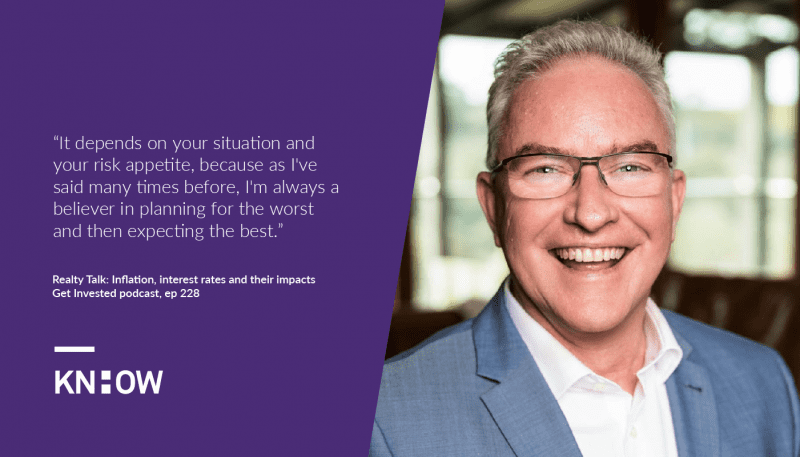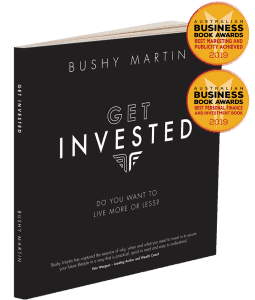The best way to tackle inflation and rising interest rates is to avoid mainstream media, reduce your risks and, if you can, capitalise on the window of opportunity.
Inflation and interest rates are big issues right now. But while the media only projects a negative commentary around these changes, KnowHow founder Bushy Martin believes there are in fact opportunities and positives – as long as you take the right actions.
“What do you need to do as rates rise by somewhere between 1.9%, up to about 2.5% over the next 12 months? Well, the answer is it depends on your situation and your risk appetite, because as I’ve said many times before, I’m always a believer in planning for the worst and then expecting the best,” he said on the Get Invested podcast.
But no matter what situation you’re in, Bushy urged people not to get swept up by the mainstream media, which is unnecessarily overwhelming and stress-inducing.
“The first thing I ask you to do is to stop reading the newspaper and stop listening to the TV or online news so that you can turn off the deluge of ill-founded, overinflated negative noise. I did this 25 years ago and have never felt better,” Bushy said.
“As we’ve seen splashed far and wide across the mainstream media in recent times, when central banks like the RBA raise interest rates, it’s big news. In recent weeks, we’ve been deluged with headlines and nightly news bulletins suggesting the rates are going to go through the roof with the cost of borrowings and repayments skyrocketing and adding to runaway inflation that’s sending sensational negative ripples across the entire economy, resulting in consumer confidence falling, mortgage stress spiralling, fewer jobs, lower wages, stock and property prices falling. And if they go too far too fast, tipping our economy back into the big, bad R word of recession.
“But despite these doomsday predictions, the reality is that interest rates only rise when our economy is travelling well and growing too strongly. So (for Australians), a rise in interest rates is a very good sign that collectively we are actually doing very well. But I bet you won’t hear that report on the news because good news just doesn’t sell advertising.”
Bushy went on to explain the best course of action depending on your situation.
Firstly, current homeowners should find out the impact these rates have on their repayments and strive to build a nest egg.
“If you’re a current homeowner, start off with finding out exactly what increased rates will do to your repayments to ensure that you can afford it. Also make sure you’re ahead in your repayments, or have a healthy three to six month rainy day savings buffer in your offset account to cover any time periods,” he said.
“If you’re looking to minimise your home loan repayments, I’d suggest sticking with discounted variable rates. So either ring your current bank and ask for a rate reduction by quoting a lower rate from another lender, or make sure you talk to a savvy mortgage broker as soon as possible to ensure that you’ve got the lowest cost line. Because our KnowHow finance broking team is saving borrowers anywhere between $400 to about $1200 a month simply by refinancing and restructuring.”
For home borrowers, Bushy’s advice is to protect yourself and minimise the risks.
“If you’re a home borrower who can’t deal with uncertainty and you want certainty of repayments, don’t fix your whole home loan, because fixed rates are now much higher than variable rates. Instead, consider splitting your loan by fixing part of your loan, but leaving an amount variable so that your offset account still operates and you’re still able to make X repayments, because most offset accounts cease to work when you fix the rate,” Bushy said.
“If you are one of the few who has been able to take advantage of the recent government loan assistance scheme to secure property with a very low deposit, tread very carefully and don’t lose your job. The softening property values may mean that you end up in a negative equity situation for a period where the value of your property is worth less than your loan. So you may want to consider taking out income protection insurance or mortgage insurance that actually protects you.”
Finally, Bushy encouraged property investors to take advantage of the small window of opportunity opening up.
“As rates rise, borrowing capacity and purchase price power reduce and property values generally soften further. So for a short period of time, smart property buyers will be able to secure properties on better terms as rates rise before the consequent reduced borrowing capacity prevents them from doing so,” he said.
“So the key here is not to leave it too long, because the best time to invest in properties is every time you can, while the majority who sit on the fence and do nothing. And with the current rental squeeze putting significant pressure on rising rents, then the cash flow affordability of holding property is actually improving, because if the experts are right in the current spate of interest rate rises is only a short term inflation curbing phenomena, and the RBA ends up reducing rates again in the latter part of next year, on top of the growing impact of reduced housing supply from construction downturns, together with the positive upward property price and rental pressure caused by opening our borders to hundreds of thousands of migrants moving forward, then the next few months will be a great time to secure property in advance of the next growth period in some of these areas.”
Bushy also recommended that property investors engage with a buyer’s agent, especially as market conditions return to ‘normal’.
“The artificial honeymoon is now over and we’re returning to more normal conditions, with every region and area’s growth cycle acting independently and out of sync with each other. So a flight to quality properties and a borderless approach to identify growth areas will now be more important than ever for long term investors,” he said.
“And if you’re serious about this, don’t do it alone. Engage a data rich buyer’s agent with boots on the ground in identified locations. It will be the best investment that you make. It’s also important to emphasise that if you are investing for the long term and are holding properties for 15 years or more, which I strongly suggest you do, then you don’t need to worry about picking property tops and bottoms because this time horizon will mean that a good property in a tightly held area will go through a complete growth cycle over this time. But if your time horizon is ten years or less and you need to grow your nest egg significantly, then you may have to adopt a more active investing approach through renovation, subdivision or property development strategies, so that you can actually manufacture and grow equity. But make sure you’re fully aware of the risks and surround yourself with proven, independent professionals who can guide you through this.”
Listen to the full interview here.
Want to Know How you can build wealth with the help of leading, qualified experts? Talk to the team at KnowHow, now.




